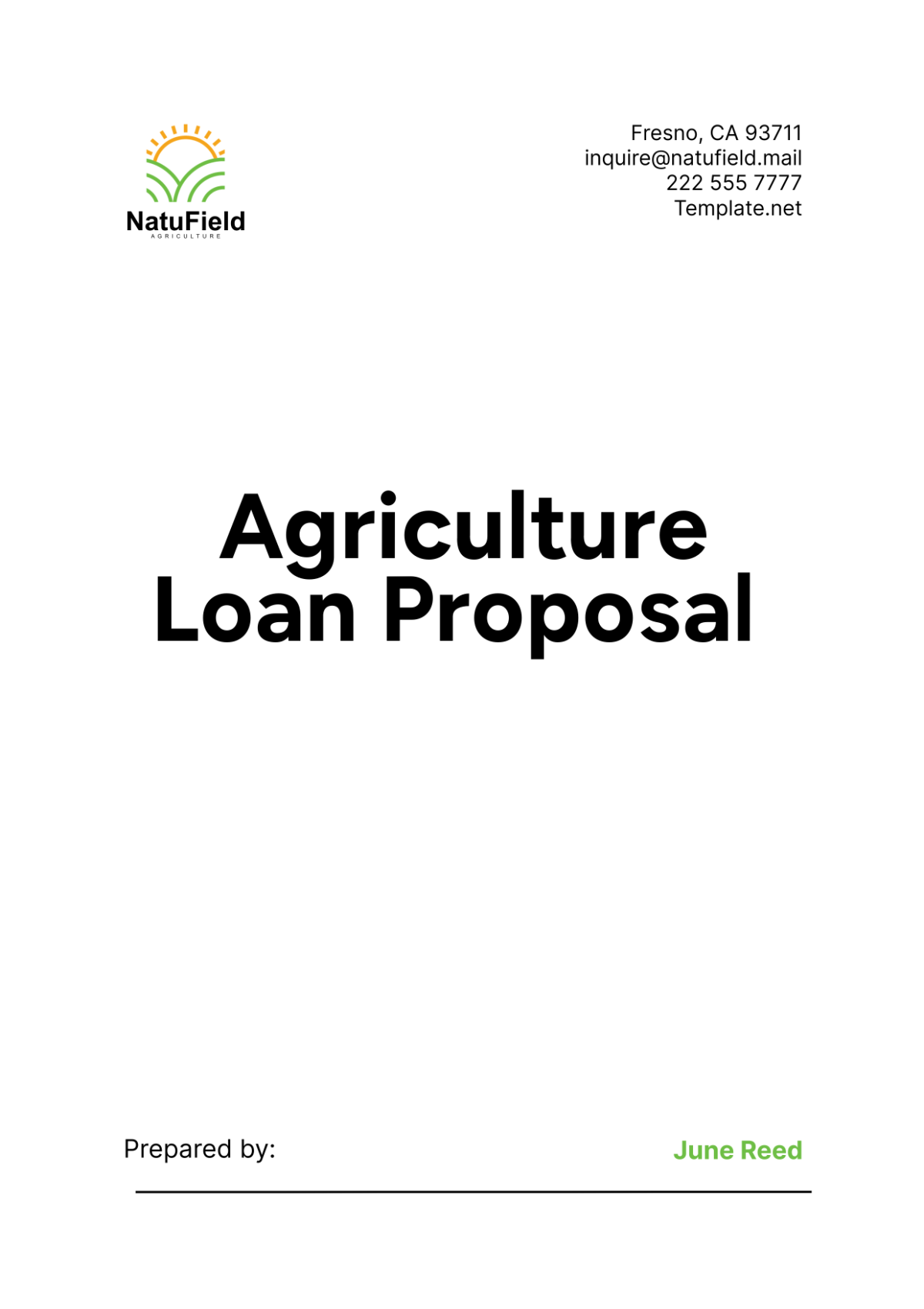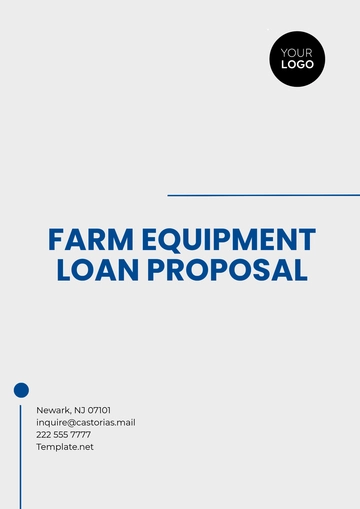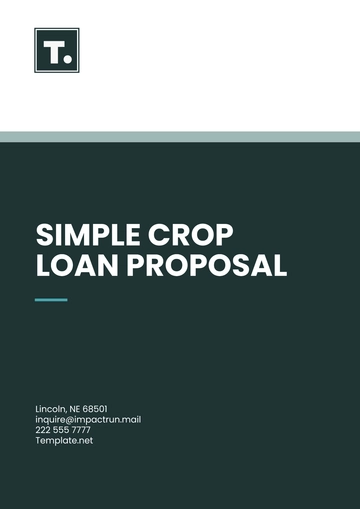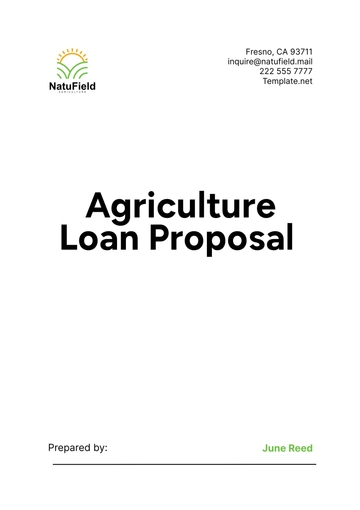Free Agriculture Loan Proposal

1. Executive Summary
This Agriculture Loan Proposal is prepared by [Your Company Name] to seek a loan of $1,000,000 for the purpose of expanding our agricultural operations. We aim to enhance our infrastructure and increase our production capacity to meet growing market demand. This proposal outlines our company details, the justification for the loan, financial health, and our strategic plan for the use of the funds and repayment.
2. Business Overview
2.1 Company Background
[Your Company Name] has been a leader in the agriculture sector since its inception in 2030. We specialize in the cultivation of [specific crops] and the production of [related products], adhering to sustainable farming practices. Our operations are spread over 2,000 acres of land in [Location], employing over 100 full-time workers and contributing significantly to the local economy.
2.2 Vision and Objectives
Our vision is to become a leading provider of sustainable agricultural products in the region. The objectives for the next five years include:
Increasing crop production by 50%.
Reducing carbon footprint by 20%.
Expanding the market reach nationally and internationally.
Implementing innovative farming techniques to improve efficiency and yield.
2.3 Current Infrastructure
Our current infrastructure includes:
2,000 acres of cultivated land.
10 storage facilities with a total capacity of 500,000 bushels.
Advanced irrigation systems covering 80% of the cultivated area.
50 units of modern farm machinery and equipment, including tractors, harvesters, and seeders.
3. Purpose of the Loan
The primary purpose of the loan is to finance:
Expansion of cultivation land.
Upgrade of existing machinery and equipment.
Research and development of new sustainable farming techniques.
Installation of advanced irrigation systems to improve water efficiency.
3.1 Detailed Allocation of Funds
Purpose | Amount ($) | Percentage (%) |
|---|---|---|
Land Acquisition | 400,000 | 40% |
Machinery and Equipment Upgrades | 300,000 | 30% |
Research and Development | 200,000 | 20% |
Irrigation Systems | 100,000 | 10% |
Total | 1,000,000 | 100% |
3.1.1 Land Acquisition
We plan to acquire an additional 500 acres of land adjacent to our current operations. This expansion will allow us to increase our crop production capacity by 25%.
3.1.2 Machinery and Equipment Upgrades
Investing in state-of-the-art machinery and equipment will improve our operational efficiency and reduce labor costs. The upgrades will include purchasing new tractors, harvesters, and automated seeders.
3.1.3 Research and Development
Allocating funds to research and development will enable us to explore and implement innovative farming techniques. This includes experimenting with new crop varieties, improving pest control methods, and enhancing soil health.
3.1.4 Irrigation Systems
Installing advanced irrigation systems on the remaining 20% of our cultivated land will ensure uniform water distribution and improve water use efficiency. This will result in better crop yields and lower water consumption.
4. Financial Information
4.1 Current Financial Health
Our financial statements for the last five years demonstrate steady growth in revenue and profits. The highlights are as follows:
Revenue Growth: An annual growth rate of 10%.
Profit Margins: Improved by 15% due to efficient resource management.
Debt-to-Equity Ratio: Maintained at a healthy 1.5:1.
4.1.1 Financial Statements (Summary)
Year | Revenue ($) | Net Profit ($) | Debt-to-Equity Ratio |
|---|---|---|---|
2045 | 5,000,000 | 500,000 | 1.5:1 |
2046 | 5,500,000 | 600,000 | 1.5:1 |
2047 | 6,050,000 | 700,000 | 1.4:1 |
2048 | 6,655,000 | 805,000 | 1.4:1 |
2049 | 7,320,500 | 925,750 | 1.3:1 |
4.2 Financial Projections
The financial projections for the next five years, assuming the loan is approved, are based on the anticipated benefits from expanded operations and improved efficiency. The projections include increased revenue and profitability.
4.2.1 Projected Financial Statements (Summary)
Year | Projected Revenue ($) | Projected Net Profit ($) | Debt-to-Equity Ratio |
|---|---|---|---|
2050 | 8,052,550 | 1,050,250 | 1.4:1 |
2051 | 8,857,805 | 1,205,288 | 1.3:1 |
2052 | 9,743,585 | 1,385,600 | 1.3:1 |
2053 | 10,717,944 | 1,593,440 | 1.2:1 |
2054 | 11,789,739 | 1,832,456 | 1.2:1 |
5. Projected Use of Funds
The allocation of the requested loan funds is crucial for the expansion and improvement of our agricultural operations. Below, we provide a detailed breakdown of how the funds will be utilized to ensure optimal use and maximum return on investment.
5.1 Land Acquisition
Amount: $400,000
Percentage: 40%
The acquisition of an additional 500 acres of land is a strategic move to increase our production capacity by 25%. This expansion is essential to meet the growing demand for our products and to maintain a competitive edge in the market.
Benefits of Land Acquisition
Increased Production Capacity: Expanding our land allows for the cultivation of more crops, thereby increasing overall yield and revenue.
Diversification: The additional land provides the opportunity to diversify crop production, reducing risks associated with market fluctuations and crop failures.
Economies of Scale: Larger land holdings can lead to cost savings in operations, such as bulk purchasing of inputs and more efficient use of machinery.
Land Acquisition Cost Breakdown
Description | Cost ($) |
|---|---|
Purchase Price (500 acres @ $700/acre) | 350,000 |
Legal Fees and Closing Costs | 25,000 |
Land Preparation and Development | 25,000 |
Total | 400,000 |
5.2 Machinery and Equipment Upgrades
Amount: $300,000
Percentage: 30%
Investing in state-of-the-art machinery and equipment is crucial for improving operational efficiency and reducing labor costs. The upgrades will include the purchase of new tractors, harvesters, and automated seeders, which are essential for modern farming practices.
Benefits of Machinery and Equipment Upgrades
Operational Efficiency: Modern machinery can perform tasks faster and more efficiently, leading to time and cost savings.
Labor Cost Reduction: Automated equipment reduces the need for manual labor, which lowers labor costs and increases productivity.
Improved Crop Management: Advanced equipment allows for more precise planting, harvesting, and pest control, resulting in higher yields and better quality crops.
Machinery and Equipment Cost Breakdown
Equipment Type | Quantity | Unit Cost ($) | Total Cost ($) |
|---|---|---|---|
Tractors | 2 | 75,000 | 150,000 |
Harvesters | 1 | 100,000 | 100,000 |
Automated Seeders | 3 | 16,667 | 50,000 |
Total | 300,000 |
5.3 Research and Development
Amount: $200,000
Percentage: 20%
Investing in research and development (R&D) will enable us to explore innovative farming techniques, which are critical for sustainable agriculture. This includes experimenting with new crop varieties, improving pest control methods, and enhancing soil health.
Benefits of Research and Development
Innovation: R&D allows us to stay ahead of industry trends and implement cutting-edge farming practices.
Sustainability: Developing sustainable farming techniques helps reduce environmental impact and ensures long-term viability.
Crop Improvement: Experimentation with new crop varieties can lead to higher yields, better resistance to pests and diseases, and improved nutritional quality.
Research and Development Cost Breakdown
R&D Activity | Cost ($) |
|---|---|
New Crop Varieties Research | 80,000 |
Pest Control Methods | 50,000 |
Soil Health Enhancements | 40,000 |
Laboratory Equipment | 30,000 |
Total | 200,000 |
5.4 Irrigation Systems
Amount: $100,000
Percentage: 10%
Installing advanced irrigation systems on the remaining 20% of our cultivated land will ensure uniform water distribution and improve water use efficiency. This will result in better crop yields and lower water consumption, supporting our sustainability goals.
Benefits of Advanced Irrigation Systems
Water Efficiency: Advanced systems use water more efficiently, reducing waste and lowering water costs.
Increased Yields: Uniform water distribution ensures that crops receive the optimal amount of water, leading to better growth and higher yields.
Sustainability: Efficient water use is a key component of sustainable farming practices, helping to conserve water resources.
Irrigation Systems Cost Breakdown
Description | Cost ($) |
|---|---|
Drip Irrigation Systems (20 acres) | 50,000 |
Sprinkler Systems (20 acres) | 30,000 |
Installation and Maintenance | 20,000 |
Total | 100,000 |
Overall Benefits and Strategic Impact
The strategic allocation of the loan funds across these four key areas will significantly enhance our operational capacity and overall business performance. By acquiring additional land, upgrading machinery and equipment, investing in R&D, and improving our irrigation systems, we are positioning [Your Company Name] for sustainable growth and long-term success.
Summary of Fund Allocation
Purpose | Amount ($) | Percentage (%) |
|---|---|---|
Land Acquisition | 400,000 | 40% |
Machinery and Equipment Upgrades | 300,000 | 30% |
Research and Development | 200,000 | 20% |
Irrigation Systems | 100,000 | 10% |
Total | 1,000,000 | 100% |
By carefully planning and allocating these funds, [Your Company Name] aims to achieve the following objectives:
Increase Crop Production: The additional land and improved machinery will allow for a 25% increase in crop production, meeting the growing market demand.
Enhance Operational Efficiency: Upgraded equipment will streamline operations, reduce labor costs, and increase productivity.
Foster Innovation: R&D investments will drive innovation in farming practices, leading to more sustainable and profitable operations.
Promote Sustainability: Advanced irrigation systems will improve water efficiency, supporting our commitment to sustainable agriculture.
The strategic use of loan funds will not only boost our production capacity but also ensure that [Your Company Name] remains at the forefront of the agricultural industry, delivering high-quality products while adhering to sustainable practices. This comprehensive approach will enable us to meet our financial obligations, drive growth, and contribute positively to the agricultural sector and the broader community.
6. Repayment Plan
[Your Company Name] proposes the following repayment plan to ensure the loan is repaid within the stipulated time frame without compromising our operational efficiency:
Loan Amount: $1,000,000
Interest Rate: 5%
Loan Term: 10 years
Monthly Installment: $10,606
6.1 Amortization Schedule (Summary)
Year | Principal Paid ($) | Interest Paid ($) | Total Payment ($) | Remaining Balance ($) |
|---|---|---|---|---|
2050 | 80,606 | 50,000 | 130,606 | 919,394 |
2051 | 84,636 | 45,970 | 130,606 | 834,758 |
2052 | 88,867 | 41,739 | 130,606 | 745,891 |
2053 | 93,310 | 37,296 | 130,606 | 652,581 |
2054 | 97,975 | 32,631 | 130,606 | 554,606 |
2055 | 102,874 | 27,732 | 130,606 | 451,731 |
2056 | 108,018 | 22,588 | 130,606 | 343,713 |
2057 | 113,419 | 17,187 | 130,606 | 230,294 |
2058 | 119,090 | 11,516 | 130,606 | 111,204 |
2059 | 125,045 | 5,561 | 130,606 | 0 |
The above table provides a summary of the principal and interest payments, total annual payment, and the remaining balance at the end of each year.
6.2 Detailed Repayment Strategy
Our repayment strategy is designed to ensure timely and consistent payments without straining our cash flow. The strategy includes:
Diversification of Income: By expanding our operations and increasing crop production, we will generate additional revenue streams.
Cost Management: Implementing cost-saving measures through efficient resource management and technological upgrades.
Contingency Planning: Setting aside a contingency fund to cover any unforeseen expenses or fluctuations in market conditions.
6.3 Revenue Generation Plan
To ensure the loan repayment, we have developed a comprehensive revenue generation plan that includes:
Expansion of Market Reach: Targeting new national and international markets to increase sales.
Value-Added Products: Developing and marketing value-added products derived from our primary crops.
Contract Farming: Engaging in contract farming agreements with local farmers to secure a steady supply of raw materials and expand our product offerings.
6.4 Risk Management
To mitigate potential risks associated with loan repayment, we have put in place several risk management strategies, including:
Insurance: Comprehensive insurance coverage for crops, machinery, and infrastructure to protect against natural disasters and other unforeseen events.
Hedging: Utilizing financial hedging instruments to manage price volatility in the agricultural markets.
Diversification: Diversifying our crop portfolio to reduce dependency on any single crop and spread risk.
7. Conclusion
We believe that the requested loan will be a strategic leverage point for [Your Company Name] to enhance our operational capacity and market reach. The detailed planning and projected financials underscore our commitment to responsible financial management and profitability. With the acquisition of additional land, upgrading of machinery and equipment, investment in research and development, and installation of advanced irrigation systems, we are poised to significantly increase our production capacity and meet the growing market demand.
Our financial projections indicate that we will be able to service the loan comfortably and ensure timely repayments. We are confident that this investment will not only enhance our business operations but also contribute to the overall growth of the agriculture sector in our region.
7.1 Long-Term Benefits
The long-term benefits of securing this loan and implementing our proposed projects include:
Increased Production Capacity: Enabling us to meet the growing demand for our products and expand our market reach.
Operational Efficiency: Reducing operational costs through advanced machinery and irrigation systems.
Sustainability: Promoting sustainable farming practices through research and development initiatives.
Economic Growth: Contributing to the local economy by creating jobs and supporting local suppliers and farmers.
7.2 Stakeholder Engagement
We are committed to engaging with our stakeholders, including investors, employees, customers, and the local community, to ensure the success of our projects. Our stakeholder engagement plan includes:
Regular Communication: Providing regular updates on project progress and financial performance.
Transparency: Ensuring transparency in our operations and financial reporting.
Community Support: Supporting local community initiatives and contributing to social and economic development.
7.3 Environmental and Social Responsibility
As a responsible agricultural company, we are committed to environmental and social responsibility. Our initiatives include:
Sustainable Farming Practices: Implementing practices that reduce environmental impact and promote biodiversity.
Resource Conservation: Utilizing water and other resources efficiently to minimize waste and reduce our carbon footprint.
Social Initiatives: Supporting local communities through education, healthcare, and infrastructure development projects.
8. Contact Information
For further information or to discuss this proposal in detail, please contact:
[Your Name]
[Your Position]
[Your Company Name]
[Your Company Email]
[Your Company Address]
[Your Company Number]
[Your Company Website]
[Your Company Social Media]
Date of Proposal Submission: January 1, 2050
- 100% Customizable, free editor
- Access 1 Million+ Templates, photo’s & graphics
- Download or share as a template
- Click and replace photos, graphics, text, backgrounds
- Resize, crop, AI write & more
- Access advanced editor
Secure your agricultural funding with Template.net's Agriculture Loan Proposal Template. Crafted to enhance your loan application process, this template provides a structured format for presenting your agricultural business's financial needs. Fully customizable and editable with our AI editor tool, it helps you articulate your funding requirements and business potential convincingly to lenders and investors.
You may also like
- Business Proposal
- Research Proposal
- Proposal Request
- Project Proposal
- Grant Proposal
- Photography Proposal
- Job Proposal
- Budget Proposal
- Marketing Proposal
- Branding Proposal
- Advertising Proposal
- Sales Proposal
- Startup Proposal
- Event Proposal
- Creative Proposal
- Restaurant Proposal
- Blank Proposal
- One Page Proposal
- Proposal Report
- IT Proposal
- Non Profit Proposal
- Training Proposal
- Construction Proposal
- School Proposal
- Cleaning Proposal
- Contract Proposal
- HR Proposal
- Travel Agency Proposal
- Small Business Proposal
- Investment Proposal
- Bid Proposal
- Retail Business Proposal
- Sponsorship Proposal
- Academic Proposal
- Partnership Proposal
- Work Proposal
- Agency Proposal
- University Proposal
- Accounting Proposal
- Real Estate Proposal
- Hotel Proposal
- Product Proposal
- Advertising Agency Proposal
- Development Proposal
- Loan Proposal
- Website Proposal
- Nursing Home Proposal
- Financial Proposal
- Salon Proposal
- Freelancer Proposal
- Funding Proposal
- Work from Home Proposal
- Company Proposal
- Consulting Proposal
- Educational Proposal
- Construction Bid Proposal
- Interior Design Proposal
- New Product Proposal
- Sports Proposal
- Corporate Proposal
- Food Proposal
- Property Proposal
- Maintenance Proposal
- Purchase Proposal
- Rental Proposal
- Recruitment Proposal
- Social Media Proposal
- Travel Proposal
- Trip Proposal
- Software Proposal
- Conference Proposal
- Graphic Design Proposal
- Law Firm Proposal
- Medical Proposal
- Music Proposal
- Pricing Proposal
- SEO Proposal
- Strategy Proposal
- Technical Proposal
- Coaching Proposal
- Ecommerce Proposal
- Fundraising Proposal
- Landscaping Proposal
- Charity Proposal
- Contractor Proposal
- Exhibition Proposal
- Art Proposal
- Mobile Proposal
- Equipment Proposal
- Student Proposal
- Engineering Proposal
- Business Proposal





























